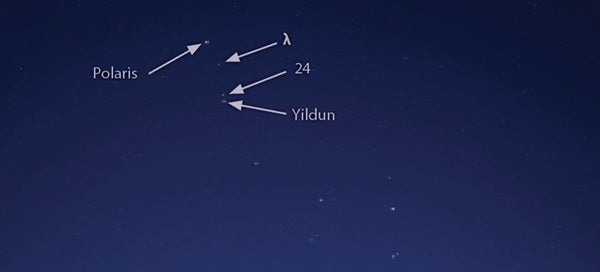Over the last several months, I’ve spent evenings seeking some of my favorite naked-eye “haunts” — dim denizens that require time and effort to see . . . or not see. Here are some of the more fun ones, including a couple that continue to evade me.
A test with staying power
In 1878, English astronomer George Hunt noted that German astronomer Eduard Heis listed Lambda (λ) Ursae Minoris in Atlas Coelestis Eclipticus, his catalog of naked-eye stars. Hunt spent more than a year searching for this star, leading him to suspect that sighting Lambda would be an excellent test of naked-eye vision.
Hunt’s failure baffled him because he consistently saw 6th-magnitude 24 UMi, which lies only 23′ north of magnitude 4.3 Yildun (Delta [δ] Ursae Minoris). So, he assumed Lambda must be closer to 7th magnitude. Actually, 24 UMi shines at magnitude 5.8, while Lambda is only 0.6 magnitude fainter. Why, then, did Hunt have such difficulty?
More than the difference in magnitude, I suspect Lambda’s location is the primary culprit. Lambda is a dim star in a void 1½° from Polaris — almost on a line between Polaris and Yildun. On the other hand, 24 UMi is a dim star relatively close to a brighter one, making locating and sighting it easier.
Hunt did finally spot Lambda, but only through a ¼-inch circular aperture. Also, back then, sighting Lambda had significance because it was the closest naked-eye star to the North Celestial Pole — a fact no longer true due to precession. Can you see 24 and Lambda? Did you have the same experience as Hunt?
Resolving the “mist”
Lots of amateur astronomers adore the Coathanger (Collinder 399) asterism. This remarkable 90′-wide gathering lies only 4° northwest of Alpha (α) Sagittae. Through binoculars, you’ll see a line of six stars (oriented east–west) with a southward-dipping hook of four stars. Keen-eyed observers can see it without optical aid as a magnitude 3.5 mist in the Milky Way. It was first described by Persian astronomer Abd al-Rahman al-Sufi in his Book of Fixed Stars, which appeared in a.d. 964.
But if you dedicate half an hour to studying that patch with your unaided eyes using averted vision, see if the mist doesn’t dissolve into flecks of starlight. In fact, five of the Coathanger’s stars shine between magnitude 5.2 and 6.3, and seven of them are brighter than 7th magnitude. Its two brightest stars, 4 and 5 Vulpeculae, are magnitude 5.2 and 5.6, respectively. I have seen the five brightest with effort.
Now set your gaze 5° north-northeast of 4 Vulpeculae for an overlooked challenge: magnitude 4.4 Alpha Vulpeculae, which has a magnitude 5.8 companion (8 Vulpeculae) 7′ to its northeast. This is a much more reasonable challenge than Zubenelgenubi listed below.
No success yet
One object that continues to baffle me is Zubenelgenubi (Alpha Librae). The magnitude 2.8 primary has a magnitude 5.2 companion 3.8′ to its northwest. Now, if you consider the Double-Double (Epsilon [ε] Lyrae) to be difficult with its stars having magnitudes of 4.7 and 5.2 (a brightness difference of 60 percent) and separated by 3.5′, imagine how much more difficult the task will be with a primary being nine times brighter than the secondary, as is the case with Zubenelgenubi. Nevertheless, observers have succeeded in splitting them.
In 1896, Walter Gale, a Fellow of the Royal Astronomical Society, scoffed at the idea of Alpha Capricorni (4.3, 3.6; 6.3′) and Mu (μ) Scorpii (3.0, 3.5; 5.8′) being tests for naked-eye vision, adding that even Epsilon Lyrae was “easy to detect.” He went on to say that, while he had heard that Alpha Librae had not been split with the unaided eye, he would like to “place on record the ease with which α1 and α2 Librae are visible in our clear skies” — in Paddington, Sydney, Australia. Alas, I have yet to succeed, even from Botswana.
As always, send reports to sjomeara31@gmail.com. I’d love to hear from young observers, and from veteran observers who may have had eye surgery or those who wear special observing glasses, to see if these advancements help keep their vision forever young.










